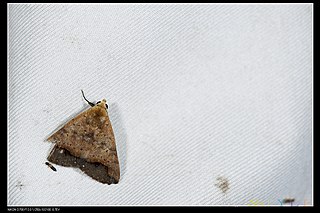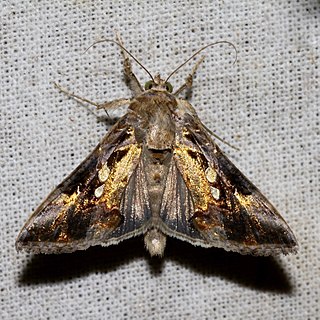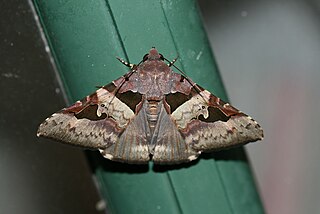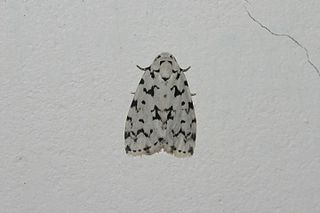
Mocis frugalis, the sugarcane looper, is a moth of the family Erebidae. The species was first described by Johan Christian Fabricius in 1775. It is found in several parts of the world, including India, Sri Lanka, West African countries and other Oriental regions. The adult is a fruit piercer and a major pest of crops.

Bocula xanthostola is a moth of the family Erebidae first described by George Hampson in 1926. It is found in Sri Lanka, Peninsular Malaysia, Sumatra and Borneo.

Argyrogramma signata, the green semilooper, is a moth of the family Noctuidae.

Mythimna decisissima is a moth of the family Noctuidae first described by Francis Walker in 1856. It is found from India across south-east Asia including Hong Kong, Japan, Taiwan and Australia in Queensland and New South Wales. It is also present in South Africa.

Mythimna irrorata is a moth of the family Noctuidae first described by Frederic Moore in 1881. It is found in the north-western parts of the Himalayas and Sri Lanka.

Ercheia cyllaria is a species of moth of the family Erebidae first described by Pieter Cramer in 1779. It is found in the Indian subregion, Sri Lanka, Taiwan, Japan, Indochina, Thailand, Peninsular Malaysia, Sumatra, Borneo, Seram and the Kai Islands.

Bastilla absentimacula is a moth of the family Noctuidae. It is found from the Indian subregion to Sri Lanka, Andaman Islands, Taiwan, Java and New Guinea.
Dysgonia rigidistria is a moth of the family Noctuidae first described by Achille Guenée in 1852. It is found on the Indian peninsula and Sri Lanka.

Ctenoplusia limbirena, the Scar Bank gem, or silver U-tail, is a moth of the family Noctuidae. It is found in south-western Europe, Africa, the Canary Islands, Arabia, the southern Himalayas, India, Sri Lanka, Indochina to south-eastern China, Taiwan, Sulawesi, Bali and Timor. In New Zealand, it has been established since 2011.

Avatha bubo is a species of moth of the family Erebidae. It is found in Sundaland, Sulawesi, Seram, throughout India, Sri Lanka and Andaman Islands.
Acrapex hamulifera is a moth of the family Noctuidae first described by George Hampson in 1893. It is endemic to Sri Lanka.
Meganola brunellus is a moth of the family Nolidae. It is found in Sri Lanka, India, Taiwan, Japan, the Ryukyu Islands, Sundaland, Queensland and the Bismarck Islands. It is an introduced species in Hawaii.

Cyclophora obstataria is a moth of the family Geometridae first described by Francis Walker in 1861. It is known from the Indian subregion, Sri Lanka and China to Sundaland, New Guinea and Queensland in Australia.

Gesonia obeditalis is a species of moth of the family Noctuidae first described by Francis Walker in 1859. It is found from eastern Africa, the Seychelles, the Maldives and the Oriental tropics of India, Sri Lanka east to the Philippines, the Sula Islands and Australia. The adult moth has brown wings with a scalloped dark brown band near the margin. The hindwings are similar in pattern to the forewings but are a paler shade of brown.

Lacera alope, the toothed drab, is a moth of the family Erebidae. The species was first described by Pieter Cramer in 1780. It is found in Africa, where it is known from southern and eastern Africa, including several islands of the Indian Ocean, Saudi Arabia, and southern Asia from India, Sri Lanka to China.

Autoba abrupta is a species of moth of the family Erebidae. It is found in Papua New Guinea, Thailand, and Australia. The species is largely used by the name Eublemma abrupta in Indian and Sri Lankan texts.

Diduga flavicostata is a moth of the family Erebidae first described by Snellen in 1879. It is found on Java, as well as in Australia, India, Sri Lanka, Myanmar, Malaysia, China and Japan.
Racotis boarmiaria is a species of moth of the family Geometridae described by Achille Guenée in 1857. It is found in India, Sri Lanka, Maldives, Myanmar, China, Japan, Taiwan, Indonesia, Bhutan and Malaysia.

Aemene taprobanis is a moth of the family Erebidae. It was described by Francis Walker in 1854. It is found in China (Li-Kiang), the north-western Himalayas, India, Sri Lanka and Malacca.
Acantholipes trajecta is a species of moth in the family Erebidae first described by Francis Walker in 1865. It is found in South Africa, India, Sri Lanka, and Australia, where it has been recorded from Western Australia, the Northern Territory and Queensland.













